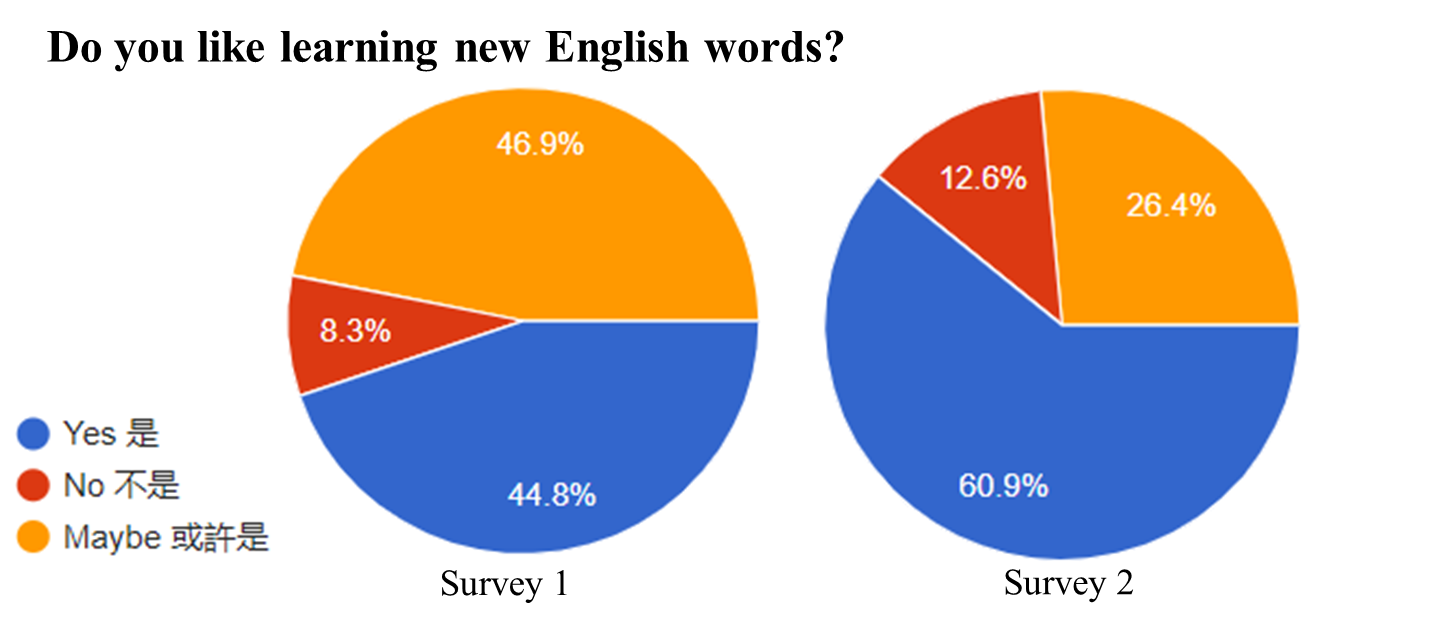Facilitating students’ reading to learn capabilities through nurturing them into self-directed vocabulary learners
Background
With a view to developing students to be lifelong learners, Yaumati Catholic Primary School (Hoi Wang Road) has made self-directed learning and reading to learn skills their major development focuses. Vocabulary enrichment in Primary 4 was chosen as the entry point for implementing the initiatives as research shows that vocabulary knowledge is closely related to students’ ability and confidence in comprehending unfamiliar texts independently, which are essential for them to read to learn.
Level
P4
Strategies used
Explicit teaching of vocabulary building skills
In order to equip students with the skills and confidence in learning, remembering and using new words independently, teachers explicitly taught a range of carefully selected vocabulary building skills with emphasis placed on helping students understand what the target vocabulary building skills are, when and how to use them, and why it would be beneficial to use themIncorporating the learning and application of the target vocabulary building skills into unit design
When planning their school English Language curriculum, teachers matched the target vocabulary building skills with the most suitable texts in the textbook units. They also provided students with many opportunities for applying these skills in their learning. Some of these target skills included guessing meanings of unknown words, identifying synonyms and using dictionaries and thesauri.Implementing a self-directed vocabulary learning programme
Students were encouraged to apply the target vocabulary learning skills and enrich their own vocabulary outside class time. A self-directed vocabulary learning programme aiming at facilitating students to learn new words of their own choice and at their own pace was introduced after they had shown basic mastery of the target vocabulary building skills.Gamifying vocabulary learning to enhance students’ interest in learning English words
e-Learning activities were employed to facilitate peer learning and gamify the learning process, thereby, enhancing students’ interest in learning English words. For instance, students were invited to contribute interesting new words and their meanings to their class-based digital word wall and vote for the best contribution made, so that they could learn and appreciate each other’s work. Online competitions and games on the target words were also held regularly inside and outside class time for students to review and recycle the new words constantly in a fun way.
What happened
Planning with an end in mind
After deciding to build their P4 students’ foundation for reading to learn through developing them into self-directed vocabulary learners, teachers discussed and agreed on the expected learning outcomes, assessment tools to use and evidence of student learning to collect for evaluating the effectiveness of the programme.- make better word choices, such as replacing simple words with synonyms; and
- use the new words they acquired in self-directed learning tasks.
- Formative and summative assessments
- Self-evaluation checklists and reflection notes
- A student survey
- Students’ writing completed during the school term with:
- annotations and highlighting of the sophisticated words they used
- notes they made about their word choices in the self-reflection part
- Scripts of writing exams
- Students’ responses about the impact of the programme on their word choices in the student survey
Selecting and incorporating the target vocabulary building skills into the school English Language curriculum
Teachers selected appropriate vocabulary building skills to focus on in P4 with reference to the English Language Education Key Learning Area Curriculum Guide (Primary 1 – Secondary 6). Some examples of the target vocabulary building skills included:inferring word meaning using contextual clues and knowledge of word formation;
learning definitions and pronunciation of unfamiliar words using online dictionaries;
using thesauri to learn synonyms and antonyms of the target words; and
recording and retaining the new words collected.
Implementation of the self-directed vocabulary learning programme
At the beginning of the programme, students were introduced to the rationale behind each component in the self-directed learning process and the expected learning outcomes of the programme. Students were required to set the target for the number of new words they planned to learn within the given period of time, choose the target skills they would like to practise, monitor and evaluate their own progress, which would give them information to help themselves do better in the next phase of the programme.Students made use of the self-directed vocabulary learning journal to record their learning process and the new words they learnt in the programme and they were encouraged to share the evidence and reflections on their learning with a family member so that they could benefit from the feedback received to further improve their learning in the next phase.
Incorporating assessment as, for and of learning into daily teaching
Teachers employed various assessment strategies in this project to inform them of their students’ learning progress so that they could take follow-up actions, such as re-teaching the vocabulary building skills, if necessary. They made use of questions asked about the target skills during lessons, reading assignments and formal assessments to evaluate their students’ mastery of the target skills. Apart from this, assessment rubrics were also employed to encourage their students to write or speak with more variety of sophisticated vocabulary they learnt in the programme. These rubrics and their rationale were shared and explained to students before they were engaged in the tasks, so that they could take the initiative and make an effort to achieve the success criteria, and develop the habit of putting more thoughts to the word choices in their writing and speaking in the future.
Assessment rubrics used to encourage students to improve their word choice in writing
Integrating games and competitions into the learning process
Games and competitions which required students to apply the target vocabulary learning strategies and new words acquired were held regularly inside or outside class time to gamify the learning process and enhance students’ interest in learning English words. Some examples of games include races, word search puzzles, charades and escape rooms.
Expected learning outcomes |
Assessment tools |
Evidence to collect |
In their writing, students should be able to: |
An excerpt of the expected learning outcomes, assessment tools to use and evidence of student learning to collect
Only one to two target skills were introduced in each term. These target skills were taught explicitly during reading lessons in the earlier textbook units and students were given many opportunities to practise applying these skills in all components of the curriculum, such as reading, writing and speaking, in the rest of the school term.
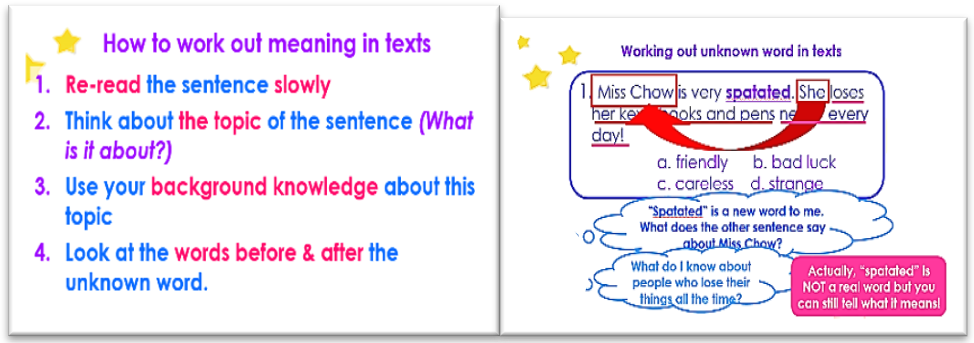
Some PowerPoint slides used to teach a vocabulary building skill explicitly
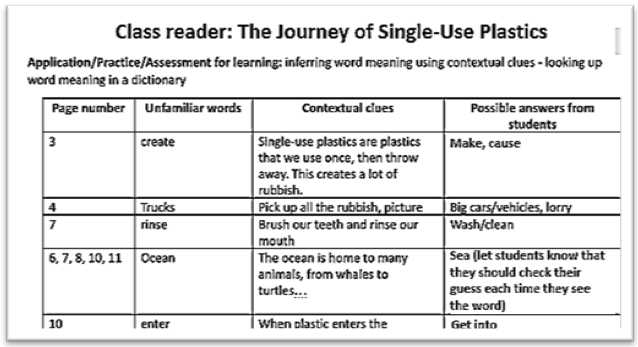
An extract of the teachers’ plan on letting their students apply the target vocabulary skills during a reading lesson
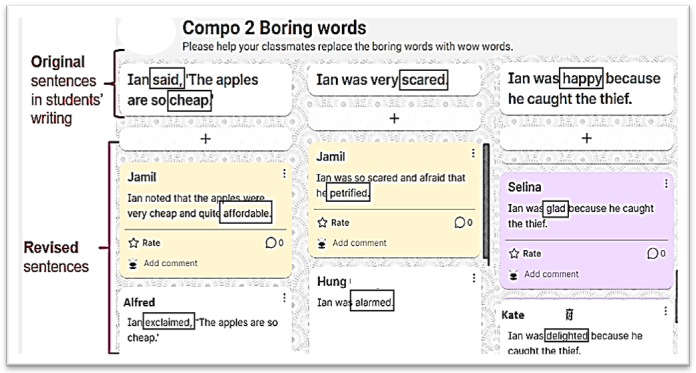
A Padlet wall used in a writing feedback lesson for students to improve their diction using
the thesaurus or words they collected in their self-directed vocabulary learning journal
the thesaurus or words they collected in their self-directed vocabulary learning journal
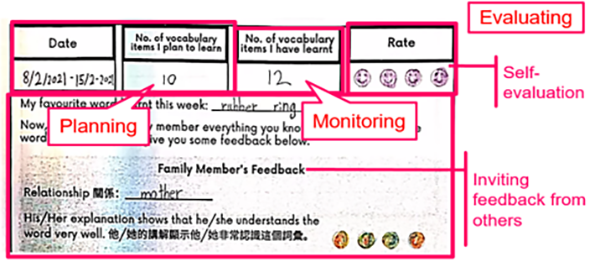
A sample of a student’s plan and evaluation in the self-directed vocabulary learning journal
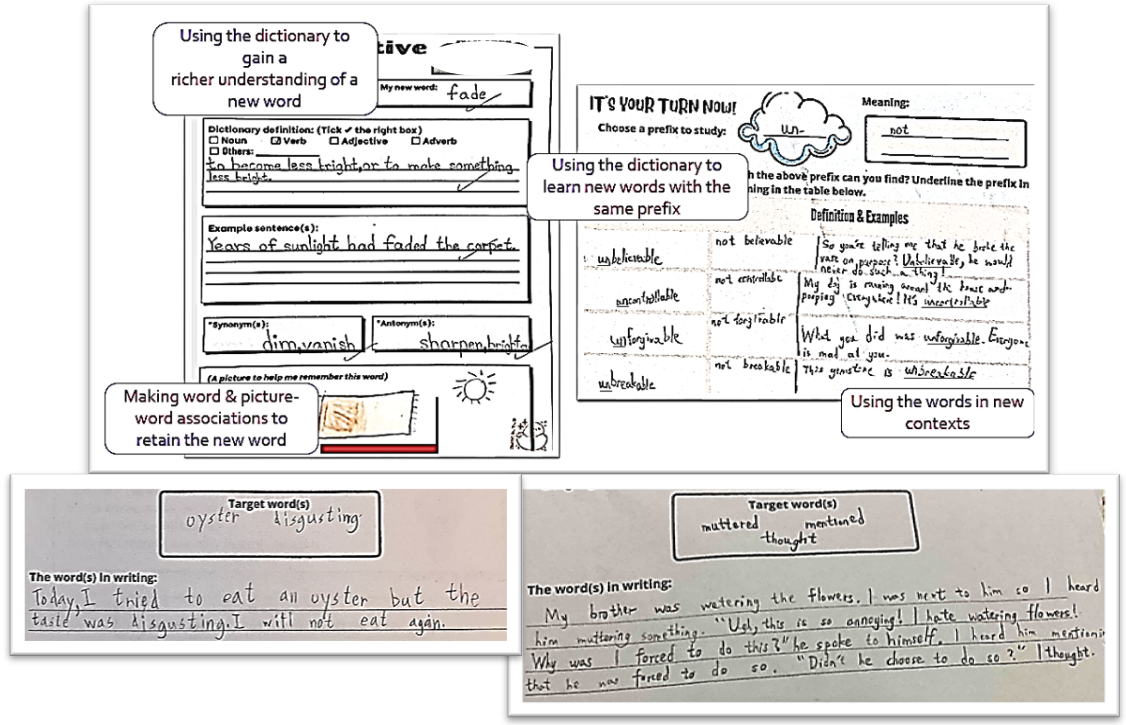
Samples of students’ entries made in their self-directed vocabulary learning journals
Impact
Curriculum level
With more emphasis placed on developing students’ self-directed learning and vocabulary building skills, a stronger alignment has been achieved between curriculum planning, student learning and assessment. Various assessment tools, such as the questions specifically set for use during lessons and in formal assessments, assessment rubrics of writing and speaking tasks, were employed to evaluate the effectiveness of their students’ learning of the target vocabulary building skills. This helped enhance the quality of assessment practices and nurture an assessment for learning culture at this school.
Teacher level
Through implementing the initiatives, the teachers involved have gained more experience and confidence in helping their students develop their self-directed learning capabilities, as well as teaching the target vocabulary building skills explicitly. They were also able to employ various e-learning tools and platforms to enrich their students’ learning experiences, enable collaborative learning and enhance their engagement in learning.
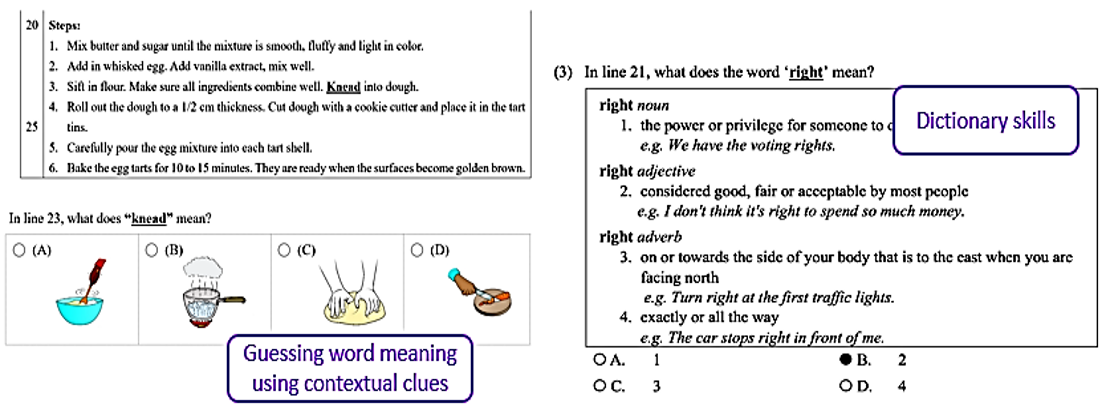
Questions for assessing students’ mastery of the target vocabulary building skills in a reading assessment paper
Student level
Many students have shown an improvement in making use of the target vocabulary building skills. The majority of them were able to answer the questions on inferring word meaning using contextual clues and understanding unfamiliar words with prefixes, which are essential skills that facilitate students’ reading to learn capabilities.
Students were also more willing to apply the new words they learnt in writing and speaking, which is an effective strategy to help them retain the new words they learnt.
Most students were also able to demonstrate a basic mastery of the target self-directed learning skills, which included setting their own learning goals, taking appropriate actions to implement their plans, reflecting on their own performance and making use of the information to further improve their performance in the next phase of the practice.
A student survey was conducted at the beginning of the school term and another at the end of it. Students’ responses in the two surveys indicated that more students were interested in learning English words after the first year of the programme.
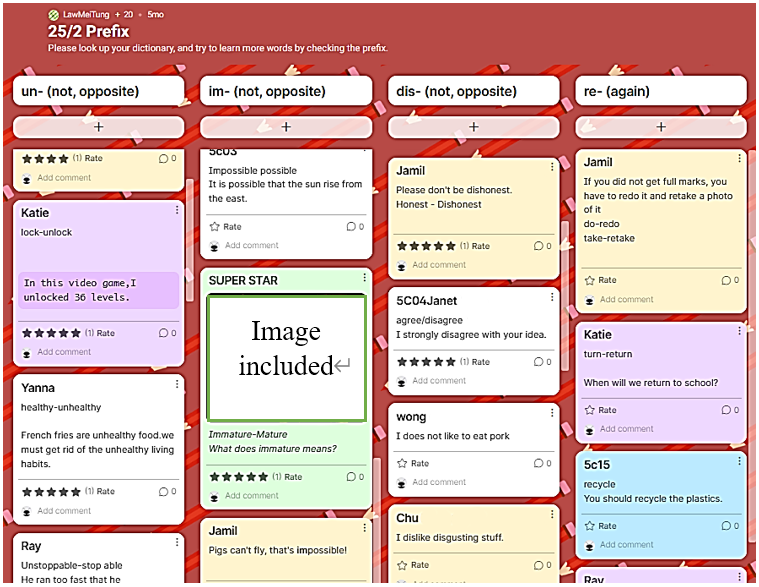
An example of a Padlet created to promote peer learning of prefixes among students

Samples of writing that illustrates students’ efforts in making use of the new words they learnt
and the highlighted words are evidence that they were monitoring their own performance
and the highlighted words are evidence that they were monitoring their own performance
|
|
Conclusion
Based on students’ performance and their responses in the programme, teachers were encouraged and ready to extend the practices in P4 to P5 and P6 in the coming school years. They would continue to introduce more self-directed vocabulary learning skills in the upper levels systematically and develop their students’ interest in learning new words using the same approaches.
Apart from vocabulary learning, teachers planned to incorporate self-directed learning into the reading and writing components in the curriculum. Also, as students have gained more confidence in handling reading texts independently with the skills they acquired in handling unfamiliar words in various contexts, teachers would focus on developing reading to learn capabilities.
Bibliography
Curriculum Development Council. (2017). English Language Education Key Learning Area Curriculum Guide (Primary 1 – Secondary 6). Hong Kong: Author.
National Reading Technical Assistance Center. (n.d.). A Research Synthesis: A Review of the Current Research on Vocabulary Instruction. Retrieved July 29, 2022, from https://www2.ed.gov/programs/readingfirst/support/rmcfinal1.pdf
Yaumati Catholic Primary School (Hoi Wang Road)
Ada LAM (Language Support Officer)
